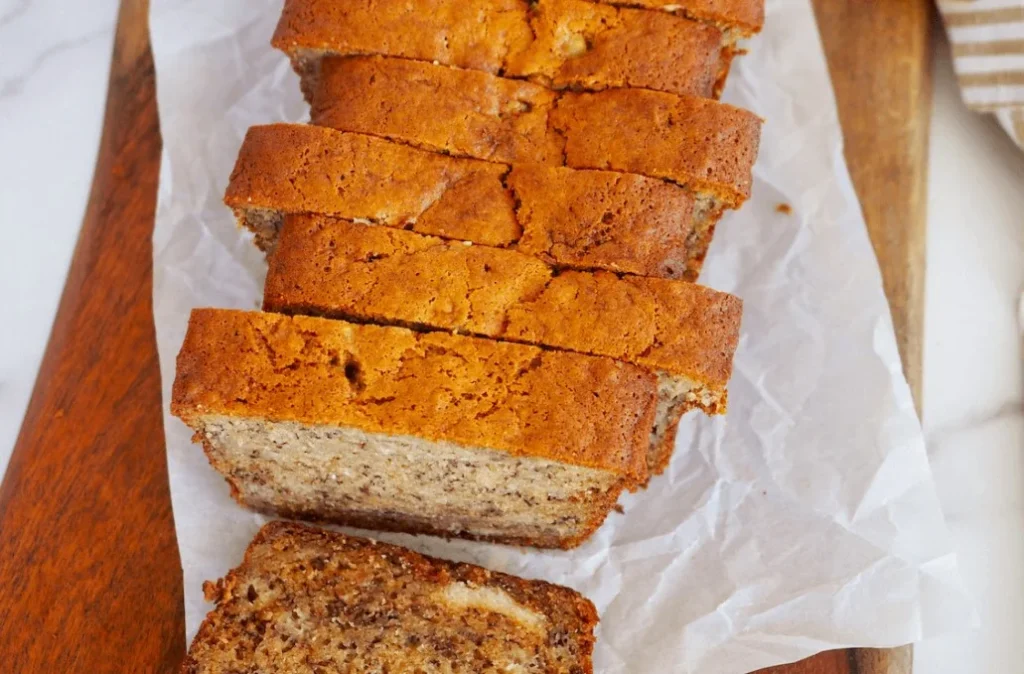This banana bread high altitude recipe is my go-to when I want something moist, fluffy, and perfectly sweet even in the mountains. I’ve carefully adjusted the ingredients to avoid dryness or sinking, which can easily happen up here.

Every bite is full of rich banana flavor with just the right balance of cinnamon and vanilla. I love how the top gets that golden, crackly crust while the inside stays soft and tender.
Whether you live at 5,000 or 8,000 feet, this loaf rises beautifully and tastes like comfort in every slice. It’s my cozy, high-altitude baking success.
Can You Bake Bread At Higher Altitude?
Yes, you can bake bread at higher altitudes, but it requires a few important adjustments. At higher elevations, the air pressure is lower, which causes dough to rise faster and liquids to evaporate more quickly.
This can lead to dry bread or loaves that rise too much and then collapse. When I bake bread in the mountains, I reduce the yeast slightly, add a bit more flour, and often increase the oven temperature by 15 to 25 degrees Fahrenheit.
I also keep a close eye on the dough during proofing, since it can double in size much faster than it would at sea level. With a few simple tweaks, I always get soft, well-risen, and flavorful loaves—even at high altitude.
How To Adjust A Bread Recipe For High Altitude?
To adjust a bread recipe for high altitude, I make a few simple changes that help the dough rise properly and bake evenly. Because the air pressure is lower, the dough tends to rise faster, which can lead to over-proofing or collapsed loaves.
I usually reduce the yeast slightly and add a tablespoon or two of extra flour to strengthen the structure. I also increase the oven temperature by 15 to 25 degrees Fahrenheit to help the bread set more quickly. If the dough feels too dry, I add a little extra water to balance out the faster evaporation.
Most importantly, I keep an eye on the dough rather than relying on time—it often rises much quicker up here. With these small adjustments, my bread always turns out soft, tall, and perfectly golden.
How To Make Banana Bread High Altitude Recipe?
- Preparation Time: 15 minutes
- Cooking Time: 55 minutes
- Total Time: 1 hour 10 minutes
- Course: Breakfast, Snack, Dessert
- Cuisine: American
- Difficulty: Easy
- Yield: 1 loaf (8–10 slices)
Equipment Needed
- 9×5-inch loaf pan
- Mixing bowls
- Measuring cups and spoons
- Whisk
- Rubber spatula
- Toothpick or cake tester
- Oven
Ingredients
- 3 ripe bananas (medium-sized, mashed)
- 2 large eggs (room temperature)
- ½ cup unsalted butter (melted and slightly cooled)
- ¾ cup brown sugar (packed)
- 1 teaspoon vanilla extract
- 1 ¾ cups all-purpose flour
- ½ teaspoon baking soda
- ½ teaspoon baking powder
- ¼ teaspoon salt
- ½ teaspoon ground cinnamon (optional)
- 1 tablespoon milk (to add moisture)
- 1 tablespoon extra flour (altitude adjustment)
Step-by-Step Instructions
1. Preheat and Prep
I preheat my oven to 350°F (175°C). Then I grease my 9×5-inch loaf pan with butter or line it with parchment paper.
2. Mix Wet Ingredients
In a large bowl, I mash the bananas until smooth. I whisk in the eggs, melted butter, brown sugar, milk, and vanilla extract until well combined.
3. Combine Dry Ingredients
In another bowl, I whisk together the flour, baking soda, baking powder, salt, cinnamon, and the extra tablespoon of flour. This extra flour helps with the structure at high altitude.
4. Fold Together
I slowly mix the dry ingredients into the wet using a rubber spatula. I stir until just combined, making sure not to overmix.
5. Pour and Bake
I pour the batter into the prepared pan and smooth out the top. Then I bake it for 50–60 minutes. I always check with a toothpick—if it comes out clean, it’s done.
6. Cool Before Slicing
I let the banana bread cool in the pan for 10 minutes before transferring it to a wire rack. I wait another 20–30 minutes before slicing.
Serving Suggestions
I love serving this banana bread warm, fresh out of the oven with a pat of butter slowly melting into each slice. Sometimes I spread a little cream cheese or peanut butter on top for extra richness.
It also makes a cozy breakfast with a cup of coffee or chai on the side. When I have leftovers, I toast a slice and drizzle it with honey or maple syrup for a quick treat.
For something special, I even turn it into French toast—it soaks up the egg mixture beautifully and tastes amazing with a dusting of cinnamon sugar.
Tips and Variations
- For High Altitude: I reduce the sugar slightly and add 1 tablespoon more flour to help the structure.
- Add-ins: Sometimes I throw in chopped walnuts, dark chocolate chips, or shredded coconut.
- Healthier Twist: Swap half the flour for whole wheat and use coconut oil instead of butter.
- Spiced Up: I add nutmeg or pumpkin spice for a seasonal twist.
- Vegan Option: Replace eggs with flax eggs and use plant-based butter.
Nutrition Facts (Per Slice – 10 slices per loaf)
- Calories: 215
- Fat: 9g
- Carbohydrates: 30g
- Sugar: 14g
- Protein: 3g
- Fiber: 1.5g
- Sodium: 160mg
Health Benefits
This banana bread isn’t just delicious—it’s also packed with benefits:
- Bananas give me a potassium boost and help with digestion.
- Cinnamon (if added) helps balance blood sugar.
- Using whole wheat flour adds fiber and keeps me full longer.
- I avoid artificial ingredients and keep things simple and wholesome.
Notes
- High altitude baking starts affecting recipes above 3,000 ft. I live around 6,000 ft, and these adjustments work great for me.
- If your altitude is higher, you might need to slightly reduce the baking soda or increase the oven temperature by 15–25°F.
- Always use ripe bananas with brown spots—they’re sweeter and mash better.
FAQs
1. What altitude is considered “high altitude” for baking?
Baking is affected at elevations starting around 3,000 feet above sea level. I live above that range, so I had to adjust my banana bread recipe to avoid dryness, collapse, or underbaking.
2. Why does banana bread bake differently at high altitudes?
At higher elevations, the air pressure is lower. That means liquids evaporate faster and baked goods rise too quickly—then collapse. That’s why I add a bit more flour, adjust the sugar, and watch the baking time closely.
3. How can I keep my banana bread moist at high altitude?
I use ripe bananas, a bit of milk, and avoid overmixing. I also keep the oven temperature steady and never overbake.
4. Can I make this banana bread gluten-free?
Yes! I’ve swapped the all-purpose flour with a 1:1 gluten-free baking flour, and it turned out great. Just keep an eye on the texture and don’t overmix.
5. What should I do if the banana bread sinks in the middle?
That usually means the bread rose too quickly. I recommend adding a bit more flour, reducing the baking soda slightly, or increasing the oven temperature by 15–25°F if you live at very high altitudes.
6. How do I store banana bread?
Once it cools, I wrap it tightly in foil or keep it in an airtight container. It stays fresh for 3–4 days at room temp, or I refrigerate it for up to a week.
7. Can I freeze banana bread?
Absolutely. I wrap individual slices in plastic wrap, then seal them in a freezer bag. They last up to 2 months in the freezer. I reheat a slice in the toaster or microwave when I need a quick breakfast.
8. Can I add nuts or chocolate chips to this recipe?
Yes, and I often do! I love folding in ½ cup of chopped walnuts or dark chocolate chips. It adds a nice crunch or richness without needing other changes.
9. Do I need to adjust baking time for higher elevations?
Sometimes. I find that baking at high altitude often requires a slightly shorter baking time, but I always use a toothpick to test around the 50-minute mark.
10. What makes this banana bread different from regular recipes?
This version has specific tweaks for high elevation—less sugar, more flour, and balanced leavening—so it won’t sink, dry out, or turn dense. It’s fluffy and flavorful every time.
Conclusion
I made this banana bread high altitude recipe right in my mountain kitchen, and it turned out soft, moist, and absolutely delicious. It rises beautifully without sinking and keeps its rich banana flavor in every bite.
With just a few small adjustments, I can finally enjoy perfect banana bread—even way up here. It’s easy to make, comforting to eat, and something I reach for whether I want a quick breakfast or a cozy snack. Try it once, and I think you’ll fall in love with it just
Banana Bread High Altitude Recipe
Ingredients
Equipment
Method
- I preheat my oven to 350°F (175°C). Then I grease my 9×5-inch loaf pan with butter or line it with parchment paper.
- In a large bowl, I mash the bananas until smooth. I whisk in the eggs, melted butter, brown sugar, milk, and vanilla extract until well combined.
- In another bowl, I whisk together the flour, baking soda, baking powder, salt, cinnamon, and the extra tablespoon of flour. This extra flour helps with the structure at high altitude.
- I slowly mix the dry ingredients into the wet using a rubber spatula. I stir until just combined, making sure not to overmix.
- I pour the batter into the prepared pan and smooth out the top. Then I bake it for 50–60 minutes. I always check with a toothpick—if it comes out clean, it’s done.
- I let the banana bread cool in the pan for 10 minutes before transferring it to a wire rack. I wait another 20–30 minutes before slicing.
Notes
- High altitude baking starts affecting recipes above 3,000 ft. I live around 6,000 ft, and these adjustments work great for me.
- If your altitude is higher, you might need to slightly reduce the baking soda or increase the oven temperature by 15–25°F.
- Always use ripe bananas with brown spots—they’re sweeter and mash better.
